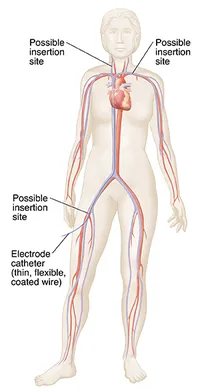Electrophysiology
An electrophysiology (EP) study is an invasive but nonsurgical procedure done by a cardiac electrophysiologist. This is a doctor who specializes in heart rhythm evaluation and treatment. The EP study can be used to:
- Assess your heart’s electrical system
- Screen for heart rhythm problems (arrhythmias)
- Guide treatment for arrhythmias
- Assess the risk for arrhythmia in certain heart conditions
Before the procedure
- Tell your doctor which medicines you take. Ask if you should stop taking them before the procedure. This is especially true for blood thinners or medicines that affect heart rate or rhythm.
- Have any routine tests that your doctor recommends. These might be blood tests or heart rhythm tests such as an electrocardiogram (ECG) or a Holter monitor.
- Follow your healthcare provider’s instructions for not eating or drinking before the procedure.
During the procedure
- The study takes about 1 to 2 hours.
- You will be given medicine through an IV (intravenous) line to help you relax.
- Your skin is numbed with a local anesthetic. This can be on the right leg, the left leg, or both.
- The doctor then puts one or several IV lines into a vein in your thigh.
- Using pulsed X-ray called fluoroscopy, your doctor will then put wires into the heart and place them in specific places to record the heart’s electrical activity.
- The electrical activity of the heart will be measured carefully. Pacing and stimulation of the heart will then be done. This involves adding additional heartbeats in an controlled fashion to test the heart’s electrical system. It also tests whether an abnormal heart rhythm can be made to happen (induced).
- Medicines that stimulate the heart can be used to help induce an abnormal heart rhythm.
- Once your doctor gets the needed information, he or she will remove the wires.
- The IV lines will be removed from the groin.
- Pressure is applied to the insertion site to prevent any bleeding.

After the procedure
You will be asked not to move your leg that had the catheter for 2 to 6 hours after the procedure. You will need to lie still in bed. A nurse will check the insertion site and monitor your vital signs. After the study, you may stay overnight, or you may go home the same day. This will depend on the results of the study, as well as the reason for the procedure. Have someone give you a ride home. It’s not safe to drive after you have been given sedatives or pain medicines.
When to call your doctor
Contact your doctor if:
- The insertion site has pain, increased swelling, redness, bleeding, or drainage
- You have shortness of breath, dizziness, lightheadedness, loss of consciousness, or chest pain
- You have severe pain, coldness, numbness, or a bluish color in the leg or arm that held the catheter
- You have a fever of 100.4°F (38°C) or higher, or as directed by your healthcare provider









